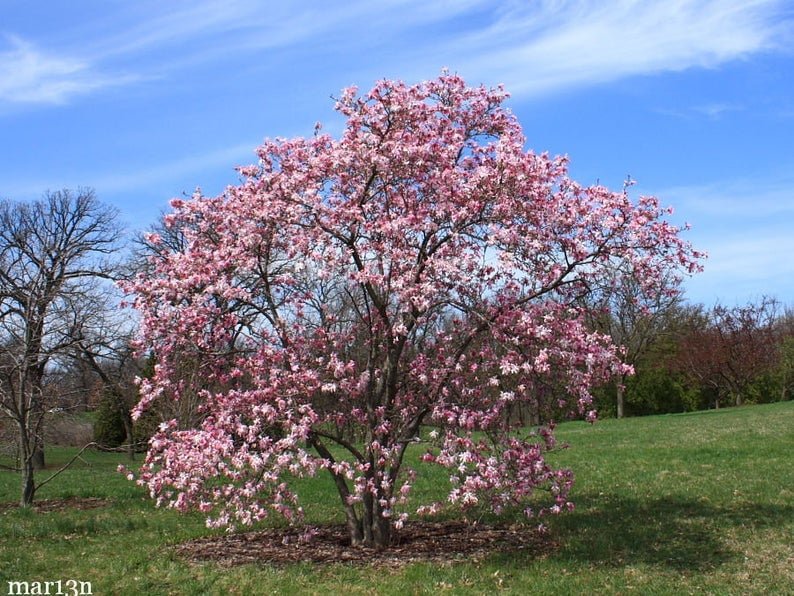The Leonard Messel magnolia is a gorgeous, flowering deciduous tree admired for its early spring blooms and compact form. This hybrid magnolia is a cross between Magnolia kobus and Magnolia stellata, combining the cold hardiness of one parent with the floral beauty of the other.
In this guide, we’ll cover everything you need to know about growing and caring for a Leonard Messel Japanese magnolia tree.
Overview of Leonard Messel Magnolia
Leonard Messel is a cultivar of Magnolia x loebneri, which is itself a hybrid between M kobus and M stellata. It was bred by the famous plantsman Sir Frederick Stern and named after the renowned British garden designer Leonard Messel.
This small magnolia tree is noted for its:
- Abundant, fragrant early spring blooms
- Frost resistance
- Compact, multi-stemmed form
- Height of 15-20 feet at maturity
The blooms emerge from fuzzy purple buds opening into 4-inch flowers with pointed white tepals blushed with pink on the outside. They appear before the leaves in early to mid spring.
Leonard Messel received the Royal Horticultural Society’s prestigious Award of Garden Merit for its outstanding qualities.
Growing Conditions
This magnolia performs best in zones 5-9. It thrives in moist, well-drained, acidic soil and appreciates partial shade, especially in hot climates. Shelter it from drying winds.
When planting, amend heavy clay or sandy soils with compost to improve drainage and nutrients. Maintain even moisture, especially while young. Leonard Messel is moderately drought tolerant once established.
Planting and Care
Follow these tips for successfully growing Leonard Messel magnolia trees:
-
Plant in early spring or fall. Container-grown trees can be planted anytime.
-
Dig a hole 2-3 times as wide as the root ball. Set the tree at the same depth it was growing in the nursery.
-
Fill the hole with amended native soil and tamp down firmly to remove air pockets. Construct a water basin around the base.
-
Water thoroughly after planting and twice weekly thereafter for the first season.
-
Apply 2-4 inches of mulch around the base, keeping it a few inches from the trunk. Replenish as needed.
-
Stake the tree for the first year if exposed to wind. Remove stakes after 1-2 years once well rooted.
-
Prune only to remove dead or damaged branches. Never trim the terminal leader.
-
Fertilize in early spring with a balanced or acidifying fertilizer.
Problems and Solutions
Leonard Messel magnolia is relatively pest and disease resistant. Potential issues include:
-
Leaf spots: Provide good air circulation and avoid wetting foliage. Remove and destroy affected leaves.
-
Powdery mildew: Improve air flow and reduce shade. Use neem oil or sulfur sprays as needed.
-
Aphids, scale, borers: Treat with horticultural oil or insecticidal soap sprays.
-
Cankers: Prune out infected areas. Disinfect tools between cuts.
-
Verticillium wilt: Improve drainage and avoid water stress. Remove and destroy affected branches.
Enjoying Leonard Messel Magnolias
As a compact, multi-stemmed specimen, Leonard Messel magnolia works well in borders, cottage gardens, courtyards, and other small-scale plantings. Pair it with early bulbs like snowdrops and crocus to extend the floral display.
The lightly fragrant, pink-tinged blooms make beautiful cut flowers. Cut a few branches to bring inside and display in a vase.
Since it stays under 20 feet tall, this magnolia can be grown in containers on decks and patios. Choose a large pot and use a quality potting mix. Provide consistent watering.
For the best floral display, select a site with full sun to part shade. Shelter from harsh winds helps protect the early blooms.
Prune after flowering is finished to shape as needed. Remove any dead or damaged growth.
With proper care, the Leonard Messel magnolia rewards gardeners with a graceful silhouette and spectacular spring blooms year after year. Its compact size makes it ideal for smaller yards.
Alternatives to Consider
If the Leonard Messel magnolia doesn’t suit your needs, here are a few alternative magnolia trees to consider:
-
Star magnolia – Magnolia stellata has a shrubby form with abundant white star-shaped flowers in early spring.
-
Saucer magnolia – Magnolia x soulangeana is a small tree with large, cup-shaped blooms in shades of white, pink and purple.
-
Oyama magnolia – Magnolia sieboldii has enormous white flowers in late spring and greater cold hardiness.
-
Loebner magnolia – Magnolia x loebneri is another compact hybrid great for small spaces and cool climates.
-
Umbrella magnolia – Magnolia tripetala is a large tree with huge leaves and upright white summer flowers.
Final Thoughts
Leonard Messel Magnolia – A Big Splash of Colour For Your Drab Spring Garden.
FAQ
How big does a Leonard Messel magnolia get?
How do you care for a Leonard Messel magnolia tree?
How far apart do you plant Leonard Messels magnolias?
Where is the best place to plant a Japanese magnolia tree?
- The Ultimate Guide to Growing Strawberries in Raised Beds - August 8, 2025
- No-Dig Garden Beds: The Easiest Way to Grow a Beautiful Garden - August 6, 2025
- How to Protect and Preserve Wood for Raised Garden Beds - August 6, 2025

